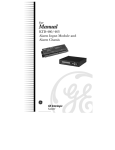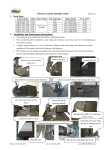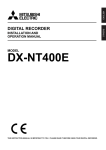Download KTD-125/127 PTZ Receivers User Manual
Transcript
KTD-125/125-24 KTD-125P/125P-24 KTD-127/127W PTZ Receivers © 2003 Kalatel, a GE Interlogix company All Rights Reserved. Any GE Interlogix, Kalatel division, software supplied with GE Interlogix, Kalatel division, products is proprietary and furnished under license and can be used or copied only in accordance with the terms of such license. This document contains proprietary information that is protected by copyright. No part of this document may be reproduced or transmitted in any form or by any means without the prior written permission of GE Interlogix, Kalatel division. The information contained in this document is subject to change without notice. GE Interlogix, Kalatel division, in keeping pace with technological advances, is a company of product innovation. Therefore, it is difficult to ensure that all information provided is entirely accurate and up-to-date. GE Interlogix, Kalatel division, accepts no responsibility for inaccuracies or omissions and specifically disclaims any liabilities, losses, or risks, personal or otherwise, incurred as a consequence, directly or indirectly, of the use or application of any of the contents of this document. This equipment has been tested and found to comply with the limits for a Class A digital device, pursuant to part 15 of the FCC Rules. These limits are designed to provide reasonable protection against harmful interference when the equipment is operated in a commercial environment. This equipment generates, uses, and can radiate radio frequency energy and, if not installed and used in accordance with the instruction manual, may cause harmful interference to radio communications. You are cautioned that any changes or modifications not expressly approved by the party responsible for compliance could void the user's authority to operate the equipment. For the latest product specifications, visit GE Interlogix, Kalatel division, online at www.GE-Interlogix.com or contact your Kalatel sales representative. For technical support before and after installation, call 800-469-1676. Technical support is available 24 hours a day, 7 days a week. Call: Fax: Web: Tech Support 800-469-1676 (6 A.M. – 5 P.M. PST Monday through Friday) Tech Support 541-740-3589 (all other times) Main 800-343-3358 or 541-754-9133 Tech Support 541-752-9096 (available 24 hours a day) Main 541-754-7162 www.GE-Interlogix.com 1040823A / June 2003 KTD-125/127 PTZ Receivers User Manual Table of Contents TABLE OF CONTENTS BEFORE YOU BEGIN ................................................................4 1 INTRODUCTION ..................................................................5 2 SETTING THE AUTOPAN JUMPER ........................................6 3 INSTALLING KTD-125 UNITS .............................................8 3.1 MOUNTING THE UNIT .................................................8 3.2 MAKING CABLE CONNECTIONS .................................11 3.2.1 4 KTD-125P Preset Positioning.....................................16 INSTALLING THE KTD-127 ...............................................18 4.1 MOUNTING THE UNIT ...............................................18 4.2 MAKING CABLE CONNECTIONS .................................20 5 INSTALLING THE KTD-127W............................................23 5.1 MOUNTING THE UNIT ...............................................23 5.2 MAKING CABLE CONNECTIONS .................................26 6 COMPLETING THE INSTALLATION (ALL UNITS) ...................29 7 PROGRAMMING THE UNITS ...............................................30 7.1 ASSIGNING A SITE ADDRESS ....................................32 7.2 TERMINATION ..........................................................32 APPENDIX A. DETERMINING THE TYPE OF PAN/TILT DRIVE .......33 APPENDIX B. USING ON-SITE TOGGLE SWITCHES ...................33 APPENDIX C. AUXILIARY POWER OUTLET (KTD-125/125P) ....34 APPENDIX D: ASSIGNING DIP SWITCH VALUES .......................34 TROUBLESHOOTING...............................................................36 1040823A / June 2003 3 Before You Begin KTD-125/127 PTZ Receivers User Manual BEFORE YOU BEGIN Read these instructions before installing or operating this product. Note: This installation should be made by a qualified service person and should conform to local codes. This manual provides installation and operation information. To use this document, you must have the following minimum qualifications: • A basic knowledge of CCTV systems and components • A basic knowledge of electrical wiring and low-voltage electrical hookups Use this product only for the purpose for which it was designed. Customer Support For assistance in installing, operating, maintaining, and troubleshooting this product, refer to this document and any other documentation provided. If you still have questions, contact Kalatel Technical Support: GE Interlogix, Kalatel division Call: 800-469-1676 Fax: 541-752-9096 Note: You should be at the equipment, ready with details before calling Technical Support. Conventions Used in this Manual Boldface or button icons highlight command entries. The following WARNING, CAUTION, and Note statements identify potential hazards: * WARNING: Improper use of this equipment can cause severe bodily injury or equipment damage. ** CAUTION: Improper use of this equipment can cause equipment damage. Note: Notes contain important information about a product or procedure. * This symbol indicates electrical warnings and cautions. ** This symbol indicates general warnings and cautions. 4 1040823A / June 2003 KTD-125/127 PTZ Receivers User Manual 1 Introduction INTRODUCTION Use a KTD-125/127 PTZ receiver and a Kalatel keypad to interface with equipment from other manufacturers and simplify common security system functions. See Table 1 for an overview of KTD-125 and KTD-127 PTZ receiver features. See Figure 1 for a typical system diagram. Table 1. Receiver descriptions and housing types Receiver Description Housing Type KTD-125 Drives a medium- or heavy-duty 115 VAC PTZ Weatherproof KTD-125-24 Drives a medium- or heavy-duty 24 VAC PTZ Weatherproof KTD-125P The KTD-125 with a preset option that allows up to 10 programmed presets Weatherproof KTD-125P-24 The KTD-125-24 with a preset option that allows up to 10 programmed presets Weatherproof KTD-127 Drives a light-duty 24 VAC PTZ requiring less than one amp Indoor only KTD-127W The KTD-127 in a weatherproof housing Weatherproof PTZ units (2) Receivers (2) RS422 Additional receivers Keypad Figure 1. KTD-125/127 receiver typical system diagram 1040823A / June 2003 5 Setting the Autopan Jumper 2 KTD-125/127 PTZ Receivers User Manual SETTING THE AUTOPAN JUMPER Note: Make the autopan jumper selection before you supply power to the unit. 1) Determine whether or not your pan/tilt drive has an internal reversing switch. (See Appendix A, Determining the Type of Pan/Tilt Drive.) 2) Locate the autopan jumper. For KTD-125 units see Figure 2; for KTD-127 units see Figure 3. Figure 2. KTD-125 autopan jumper location Figure 3. KTD-127 autopan jumper location 6 1040823A / June 2003 KTD-125/127 PTZ Receivers User Manual 3) Setting the Autopan Jumper See Figure 4 to set the autopan jumper. Connect for pan/tilt units without an internal reversing switch Disconnect for pan/tilt with an internal reversing switch Figure 4. Selecting the autopan jumper setting Note: If the pan/tilt drive has an internal reversing switch, connect the pant/tilt drive’s AUTO output to the receiver when making cable connections. Note: If the pan/tilt units does not have an internal reversing switch, the left and right limit switches will determine the points where the unit will reverse during autopan. 1040823A / June 2003 7 Installing KTD-125 Units 3 KTD-125/127 PTZ Receivers User Manual INSTALLING KTD-125 UNITS CAUTION: Complete all instruction steps before supplying power to the unit. 3.1 MOUNTING THE UNIT To mount the unit see Figure 5, Figure 6, and Figure 7 and perform the following. 1) Disconnect the power cable connector from the power input on the main relay board. Note: In most cases, it is easier to mount the unit with the main relay board removed. 2) Remove the main relay board from the housing. Main relay board Power cable connector Finger nuts Figure 5. Removing the finger nuts (KTD-125P-24 shown) 8 1040823A / June 2003 KTD-125/127 PTZ Receivers User Manual Installing KTD-125 Units Figure 6. Pulling the main relay board away from the standoffs (KTD-125P-24 shown) Note: You may need to bend the board slightly to remove it from the housing. Board brackets (2) Figure 7. Pushing the board brackets inward to free the board from the housing. (KTD-125P-24 shown) 1040823A / June 2003 9 Installing KTD-125 Units 3) KTD-125/127 PTZ Receivers User Manual To mount the housing use installer-provided fasteners and the four mounting holes in the mounting flanges (Figure 8). Note: Install the housing so that it is level and the door opens to the left. Mounting holes (4) Figure 8. Holes in the housing’s mounting flanges (KTD-125P-24 shown) Note: Do not reinstall the main relay board until instructed to do so in section 6, Completing and Testing the Installation. 10 1040823A / June 2003 KTD-125/127 PTZ Receivers User Manual 3.2 Installing KTD-125 Units MAKING CABLE CONNECTIONS For the following procedures, see Figure 9 for KTD-125/125P units and Figure 10 for KTD-125-24/125P-24 units. Watertight cable openings Camera power/zoom lens Pan/tilt Removable terminal strips 24 VAC power connector 24 VAC power pigtail Wire nut connections to the power pigtail 24 VAC power in Receiver card RS422 control in RS422 control out Figure 9. KTD-125/125P Cable routing 1040823A / June 2003 11 Installing KTD-125 Units KTD-125/127 PTZ Receivers User Manual Watertight cable openings Camera power/zoom lens Pan/tilt Removable terminal strips 24 VAC power connector To power transformer 110 VAC power pigtail Wire nut connections to the 110 VAC power pigtail 110 VAC power in Receiver card Figure 10. RS422 control in RS422 control out KTD-125-24/125P-24 cable routing To prepare the cables for connection perform the following. 1) Route the cables into the housing. 2) Remove 6 inches of the outer casing of the camera/lens, pan/tilt, and power cables. 3) Tie a knot in the RS422 cable(s) six inches from the end on the inside of the housing to act as a strain relief. 4) Remove the outer casing from the end of the RS422 cable(s). To make the cable connections perform the following. CAUTION: For the KTD-125-24 and KTD-125P-24 units, connect only 110 VAC input to the power cable pigtail. 12 1040823A / June 2003 KTD-125/127 PTZ Receivers User Manual Installing KTD-125 Units CAUTION: For the KTD-125 and KTD-125P units, connect only 24 VAC input to the power cable pigtail. 1) Use wire nuts to connect the power cable conductors to the power cable pigtail. (See Table 2.) Table 2. Power cable pigtail connectors Connector color Description Black = Hot White = Neutral Green = Ground 2) Remove the terminal strip(s) from the main relay board. 3) Make the remaining cable connections as shown in Figure 11 through Figure 14. Camera power GND. = Ground HOT = Hot NEU. = Neutral Figure 11. KTD-125 Camera Power Connections 1040823A / June 2003 13 Installing KTD-125 Units KTD-125/127 PTZ Receivers User Manual Pan/tilt control cable COM. = Common U = Up L = Left D = Down R = Right A = Auto Figure 12. KTD-125 Pan/Tilt Connections Spare relay contact R = Relay Contact Figure 13. KTD-125 Spare Relay Connections Lens control cable I = Iris F = Focus Z = Zoom COM. = Common Figure 14. KTD-125 Zoom Lens Connections 14 1040823A / June 2003 KTD-125/127 PTZ Receivers User Manual 4) Installing KTD-125 Units Remove the four-connection terminal strip from the receiver card on the main relay board. Note: Observe polarity when you connect the RS422 control cables. 5) Connect the RS422 control cable(s) as shown in Figure 15. RS422 control in RS422 control out Figure 15. KTD-125 RS422 control cable connections to the receiver card 6) For the programming preset positions with the KTD-125P, see section 3.2.1, KTD-125P Preset Positioning. For final installation steps see section 6, Completing and Testing the Installation (All Units). 1040823A / June 2003 15 Installing KTD-125 Units 3.2.1 KTD-125/127 PTZ Receivers User Manual KTD-125P PRESET POSITIONING The KTD-125P/125P-24 receivers can find up to 10 preset positions if the camera lens and pan/tilt drive are equipped with feedback potentiometers. If you program the 10 positions from the controller keypad, you can find a maximum of eight through contact closures into the receiver’s KTD-125C receiver card. Note: You can also find the preset positions using the controller keypad keys, through contact closures into the KTD-463 Alarm Interface, and through commands issued from an external computer through the KTD-312 Interface Module. The KTD-125P/125P-24 receivers include a relay that activates when one or more preset alarm contacts are closed. This allows switching of the alarmed site’s video to the monitor screen while the camera moves to the alarmed preset position. To find preset positions using contact closures into the receiver card see Figure 16 and Figure 17 and perform the following. 1) Connect the preset positioning input cable to the removable terminal strip from the main relay board. Preset positioning input cable COM. = preset common T.P. = tilt position F.P. = focus position 5V = +5 Volts DC P.P. = pan position Z.P. = zoom position Figure 16. Preset contact connections 2) Make the preset alarm contact connections to the preset connection terminal strip on the receiver card. 3) To connect the output relay to an alarm interface unit. 16 1040823A / June 2003 KTD-125/127 PTZ Receivers User Manual Relay output Installing KTD-125 Units Preset alarm input contacts Figure 17. Preset and output relay contact connections 1040823A / June 2003 17 Installing the KTD-127 4 KTD-125/127 PTZ Receivers User Manual INSTALLING THE KTD-127 CAUTION: Complete all instruction steps before supplying power to the unit. 4.1 MOUNTING THE UNIT Note: In most cases, it is easier to mount the unit with the main relay board removed. 1) Remove the main relay board from the housing as shown in Figure 18 and Figure 19. Figure 18. Removing the KTD-127 cover 18 1040823A / June 2003 KTD-125/127 PTZ Receivers User Manual Installing the KTD-127 Figure 19. Sliding out the KTD-127 card 2) To mount the housing use the two mounting holes in the housing (Figure 20) and installer-provided fasteners. Mounting holes (2) Figure 20. Mounting holes in KTD-127 housing Note: Do not reinstall the main relay board until instructed to do so in section 6, Completing and Testing the Installation (All Units). 1040823A / June 2003 19 Installing the KTD-127 4.2 KTD-125/127 PTZ Receivers User Manual MAKING CABLE CONNECTIONS See Figure 21 for the following procedures. Removable terminal strip Receiver card Camera power/zoom lens Pan/tilt 24 VAC power RS422 control out RS422 control out Figure 21. KTD-127 cable connections To prepare the cables for connection perform the following. 1) Route the cables into the housing. 2) Remove 6 inches of the outer casing from the camera/lens, pan/tilt, and 24 VAC power cables. 3) Remove the outer casing from the end of the RS422 cable(s). To make the cable connections perform the following. 1) Remove the terminal strip from the main relay board. 2) Make connections as shown in Figure 22 through Figure 24. 20 1040823A / June 2003 KTD-125/127 PTZ Receivers User Manual Installing the KTD-127 To power 1/HOT = Hot 2/COM. = Common Figure 22. KTD-127 Terminal Strip Connections, Power To camera 3 / HOT = Hot 11 / I = Iris 13 / Z = Zoom 4 / COM. = Common 12 / F = Focus 14 / COM. = Common Figure 23. KTD-127 Terminal Strip Connections, Camera To pan/tilt 5 / COM. = Common 7 / U = Up 9 / L = Left 6 / D = Down 8 / R = Right 10 / A = Auto Figure 24. KTD-127 Terminal Strip Connections, Pan/Tilt 1040823A / June 2003 21 Installing the KTD-127 3) KTD-125/127 PTZ Receivers User Manual Remove the four-connection terminal strip from the receiver card on the main relay board. Note: Observe polarity when you connect the RS422 control cables 4) Connect the RS422 control cable(s) as shown in Figure 25. RS422 control in RS422 control out Figure 25. KTD-127 RS422 control cable connections to the receiver card For final installation steps see section 6, Completing and Testing the Installation (All Units). 22 1040823A / June 2003 KTD-125/127 PTZ Receivers User Manual 5 Installing the KTD-127W INSTALLING THE KTD-127W CAUTION: Complete all instruction steps before supplying power to the unit. 5.1 MOUNTING THE UNIT Note: In most cases, it is easier to mount the unit with the main relay board removed. 1) Remove the board from the housing as shown in Figure 26, Figure 27 and Figure 28. Main relay board Finger nuts Figure 26. Removing the finger nuts 1040823A / June 2003 23 Installing the KTD-127W KTD-125/127 PTZ Receivers User Manual Figure 27. Pulling the board away from the standoffs Note: You may need to bend the board slightly to remove it from the housing. Figure 28. Pushing the board brackets inward to free the board from the housing. 24 1040823A / June 2003 KTD-125/127 PTZ Receivers User Manual 2) Installing the KTD-127W To mount the housing use installer-provided fasteners and the four mounting holes in the mounting flanges (Figure 29). Note: Install the housing so that it is level and the door opens to the left. Mounting holes (4) Figure 29. Holes in the housing’s mounting flanges Note: Do not reinstall the main relay board until instructed to do so in section 6, Completing and Testing the Installation (All Units). 1040823A / June 2003 25 Installing the KTD-127W 5.2 KTD-125/127 PTZ Receivers User Manual MAKING CABLE CONNECTIONS See Figure 30 for the following procedures. Removable terminal strip Receiver card Camera power/zoom lens Pan/tilt 24 VAC in RS422 control out RS422 control in Figure 30. KTD-127W cable routing To prepare the cables for connection perform the following. 1) Remove 6 inches of the outer casing of the camera/lens, pan/tilt, and power cables. 2) Tie a knot in the RS422 cable(s) six inches from the on the inside of the housing to act as a strain relief. 3) Remove the outer casing from the end of the RS422 cable(s). To make the cable connections perform the following. 1) Remove the terminal strip from the main relay board. 2) Make the connections as shown in Figure 31 through Figure 33. 26 1040823A / June 2003 KTD-125/127 PTZ Receivers User Manual Installing the KTD-127W To power 1/HOT = Hot 2/COM. = Common Figure 31. KTD-127W Terminal Strip Connections, Power To camera 3 / HOT = Hot 11 / I = Iris 13 / Z = Zoom 4 / COM. = Common 12 / F = Focus 14 / COM. = Common Figure 32. KTD-127W Terminal Strip Connections, Camera To pan/tilt 5 / COM. = Common 7 / U = Up 9 / L = Left 6 / D = Down 8 / R = Right 10 / A = Auto Figure 33. KTD-127W Terminal Strip Connections, Pan/Tilt 1040823A / June 2003 27 Installing the KTD-127W 3) KTD-125/127 PTZ Receivers User Manual Remove the four-connection terminal strip from the receiver card on the main relay board. Note: Observe polarity when you connect the RS422 control cables 4) Connect the RS422 control cable(s) as shown in Figure 34. Figure 34. KTD-127W RS422 control cable connections to the receiver card For final installation steps see section 6, Completing and Testing the Installation (All Units). 28 1040823A / June 2003 KTD-125/127 PTZ Receivers User Manual 6 Programming COMPLETING AND TESTING THE INSTALLATION (ALL UNITS) To finalize the cable installation, perform the following. 1) Reinstall the main relay board into the housing. 2) Reinstall the removable terminal strips onto the main relay board and receiver card. 3) Reconnect the power cable connector to the power input on the main relay board. 4) If you have a unit with a weatherproof housing, tighten the watertight cable openings. To test for proper installation, perform the following. 1) Check all connections. 2) Supply power to the unit. 3) If you have a KTD-125 unit, confirm that the power switch on the main relay board is on. 4) Test for proper operation using the on-site toggle switches on the main relay board. (See Appendix B, Using On-Site Toggle Switches) 1040823A / June 2003 29 Programming 7 KTD-125/127 PTZ Receivers User Manual PROGRAMMING THE UNITS The KTD-125 and KTD-127 PTZ receivers have several mode-ofoperation choices that you must program before you operate the units. Typically, you would program the receiver with a Kalatel controller keypad. To program the units manually using the DIP switches on the receiver card, perform the following. Site select Programming Termination Figure 35. KTD-125, KTD-127, and KTD-127W DIP Switches 1) Disconnect power from the receiver. 2) Set DIP switch 10 to ON to put the receiver in programming mode. 3) Set the DIP switches for the desired mode of operation as shown in Table 3. 30 1040823A / June 2003 KTD-125/127 PTZ Receivers User Manual Programming Note: When reentering programming mode, you must reprogram all mode-of-operation choices, even if you are only changing one. Table 3. Setting DIP switches for the desired mode of operation DIP Switch 1 2 Function Setting Zoom Polarity OFF = Zoom in positive, zoom out negative ON = Zoom in negative, zoom out positive OFF = Iris open positive, iris close negative ON = Iris open negative, iris close positive OFF = Not DC motors ON = DC motors Iris Polarity 3 Pan/Tilt Drive 4 and 5 Autopan 4 OFF + 5 OFF = Normal 4 OFF + 5 ON = Random pan 4 ON + 5 OFF = 50% duty cycle 4 ON + 5 ON = Disable autopan 6 7 8 Autopan on Power-Up Zoom Lens Voltage Invert Up and Down Tilt OFF = Yes ON = No OFF = 12 VDC ON = 6 VDC OFF = Not inverted ON = Inverted 4) Supply power to the receiver. 5) Wait 5 seconds. 6) Set DIP switch 10 to the off position to place the receiver in normal mode. To change mode-of-operation choices, repeat steps 1 through 6. 1040823A / June 2003 31 Programming 7.1 KTD-125/127 PTZ Receivers User Manual ASSIGNING A SITE ADDRESS CAUTION: Make sure the receiver is in normal operating mode before changing DIP switches 1 through 9 for site addressing. To assign a site address perform the following. Note: You can assign a site address while the unit has power. 1) Confirm that DIP switch 10 is in the off position or normal mode. 2) Determine which DIP switch values combine to equal the desired site number. (See Appendix D: Assigning DIP Switch Values.) 3) Set the DIP switches that correspond to those values to ON. 7.2 TERMINATION If the RS422 cable does not loop out of the receiver to another unit, set DIP switches 11 and 12 to ON to terminate. 32 1040823A / June 2003 KTD-125/127 PTZ Receivers User Manual Appendix APPENDIX A. DETERMINING THE TYPE OF PAN/TILT DRIVE • If the pan/tilt drive unit has an output labeled AUTO, it is has an internal reversing switch. • If the pan/tilt drive unit does not have an output labeled AUTO, it does not have an internal reversing switch. APPENDIX B. USING ON-SITE TOGGLE SWITCHES See Figure 36 and Figure 36 for the location of the on-site toggle switches. On-site toggle switches On-site toggle switches Figure 36. All KTD-125 units Up ► Down ► Figure 37. KTD-127 units Zoom Focus Iris Spare Pan Pan Tilt ▼ ▼ ▼ ▼ ▼ ▼ ▼ In Near Open Off Manual Left Up Out Far Close On Auto Right Down Figure 38. On-site toggle switch positions for all KTD-125 units 1040823A / June 2003 33 Appendix KTD-125/127 PTZ Receivers User Manual Zoom Focus Iris Pan Pan Tilt ▼ ▼ ▼ ▼ ▼ ▼ Up ► In Near Open Manual Left Up Down ► Out Far Close Auto Right Down Figure 39. On-site toggle switch positions for KTD-127 units APPENDIX C. AUXILIARY POWER OUTLET (KTD125/125P) Use the auxiliary power connection on the main relay board to power a test monitor on site or an auxiliary transformer for low voltage camera supplies. APPENDIX D: ASSIGNING DIP SWITCH VALUES One way to determine which switches to use is to subtract the highest possible switch value from the address you want, then subtract the highest possible switch value from that difference. Continue to subtract the highest possible switch value from the difference until you have zero. For example, if you want address 209: Switch Address 209 Switch Value 34 Difference Switch On 209 – 128 = 81 8 81 – 64 = 17 7 17 – 16 = 1 5 1 – 1 = 0 1 1040823A / June 2003 KTD-125/127 PTZ Receivers User Manual Appendix Therefore, for address 209, you would use switches 1 (1), 5 (16), 7 (64), and 8 (128). (See Figure A1) Figure A1. Zone address 209 (1 + 16 + 64 + 128) 1040823A / June 2003 35 Troubleshooting KTD-125/127 PTZ Receivers User Manual TROUBLESHOOTING Diagnostic check: Use the toggle switches on the main relay board to confirm that you have control of the camera from the receiver on. • If YES, then check your RS422 connections from the keyboard to the receiver. • If NO, then check your connections from the receiver to the camera/lens. Diagnostic check: Meter across the RS422 cable connections at the keyboard and receiver card. Confirm that you have 1 – 2 VDC flowing. • If YES, then check your connections from the receiver to the camera/lens. • If NO, then check your RS422 connections from the keyboard to the receiver. Problem No control of unit Probable Cause Break in RS422 connection(s) Solution Check to see that both ends of the RS422 cables are connected. Confirm that the wires are stripped enough to make a good connection. Reattach the receiver card to the main relay board to make sure it correctly seated. No control of lens 36 Break in camera/lens connection(s). Use a voltage meter and the onsite toggles to check each camera/lens connection. If there is a problem, confirm that the wires are stripped enough to make a good connection. 1040823A / June 2003













































